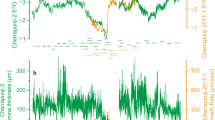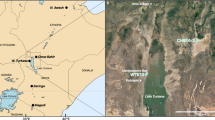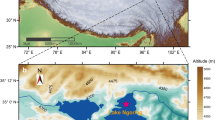Abstract
African climate is generally considered to have evolved towards progressively drier conditions over the past few million years, with increased variability as glacial–interglacial change intensified worldwide1,2,3. Palaeoclimate records derived mainly from northern Africa exhibit a 100,000-year (eccentricity) cycle overprinted on a pronounced 20,000-year (precession) beat, driven by orbital forcing of summer insolation, global ice volume and long-lived atmospheric greenhouse gases4. Here we present a 1.3-million-year-long climate history from the Lake Malawi basin (10°–14° S in eastern Africa), which displays strong 100,000-year (eccentricity) cycles of temperature and rainfall following the Mid-Pleistocene Transition around 900,000 years ago. Interglacial periods were relatively warm and moist, while ice ages were cool and dry. The Malawi record shows limited evidence for precessional variability, which we attribute to the opposing effects of austral summer insolation and the temporal/spatial pattern of sea surface temperature in the Indian Ocean. The temperature history of the Malawi basin, at least for the past 500,000 years, strongly resembles past changes in atmospheric carbon dioxide and terrigenous dust flux in the tropical Pacific Ocean, but not in global ice volume. Climate in this sector of eastern Africa (unlike northern Africa) evolved from a predominantly arid environment with high-frequency variability to generally wetter conditions with more prolonged wet and dry intervals.
This is a preview of subscription content, access via your institution
Access options
Subscribe to this journal
Receive 51 print issues and online access
$199.00 per year
only $3.90 per issue
Buy this article
- Purchase on Springer Link
- Instant access to full article PDF
Prices may be subject to local taxes which are calculated during checkout




Similar content being viewed by others
References
Cerling, T. E. Development of grasslands, savannas in East Africa during the Neogene. Palaeogeogr. Palaeoclimatol. Palaeoecol. 97, 241–247 (1992)
deMenocal, P. African climate change and faunal evolution during the Pliocene-Pleistocene. Earth Planet. Sci. Lett. 220, 3–24 (2004)
Potts, R. Evolution and climate variability. Science 273, 922–923 (1996)
Otto-Bliesner, B. et al. Coherent changes of southeastern equatorial and northern African rainfall during the last deglaciation. Science 346, 1223–1227 (2014)
Trauth, M. H., Maslin, M. A., Deino, A. & Strecker, M. R. Late Cenozoic moisture history of East Africa. Science 309, 2051–2053 (2005)
Liesecki, L. E. & Raymo, M. E. A Pliocene-Pleistocene stack of 57 globally distributed benthic δ18O records. Paleoceanography 20, PA1003 (2004)
Lüthi, D. et al. High-resolution carbon dioxide concentration record 650,000–800,000 years before present. Nature 453, 379–382 (2008)
Finney, B. P., Scholz, C. A., Johnson, T. C., Trumbore, S. & Southon, J. in The Limnology, Climatology, and Palaeoclimatology of the East African Lakes (eds Johnson, T. C. & Odada, E. O. ) 495–508 (Gordon and Breach, 1996)
Scholz, C. A. et al. East African megadroughts between 135–75 kyr ago and implications for early human history. Proc. Natl Acad. Sci. USA 104, 16416–16421 (2007)
Pearson, A. & Ingalls, A. E. Assessing the use of archaeal lipids as marine environmental proxies. Annu. Rev. Earth Planet. Sci. 41, 359–384 (2013)
Schouten, S., Hopmans, E. C. & Sinninghe Damsté, J. S. The organic geochemistry of glycerol dialkyl glycerol tetraether lipids: a review. Org. Geochem. 54, 19–61 (2013)
Winckler, G., Anderson, R. F., Fleisher, M. Q., McGee, D. & Mahowald, N. Covariant glacial–interglacial dust fluxes in the equatorial Pacific and Antarctica. Science 320, 93–96 (2008)
Albani, S. et al. Improved dust representation in the Community Atmosphere Model. J. Adv. Model. Earth Syst. 6, 541–570 (2014)
Lyons, R. P. et al. A continuous 1.3 million year record of East African hydroclimate, and implications for patterns of evolution and biodiversity. Proc. Natl Acad. Sci. 112, 15568–15573 (2015)
Lyons, R. P., Scholz, C. A., Buoniconti, M. R. & Martin, M. R. Late Quaternary stratigraphic analysis of the Lake Malawi Rift, East Africa: an integration of drill-core and seismic-reflection data. Palaeogeogr. Palaeoclimatol. Palaeoecol. 303, 20–37 (2011)
Magill, C. R., Ashley, G. M. & Freeman, K. H. Ecosystem variability and early human habitats in eastern Africa. Proc. Natl Acad. Sci. USA 110, 1167–1174 (2013)
Cerling, T. E. et al. Woody cover and hominin environments in the past 6 million years. Nature 476, 51–56 (2011)
Cohen, A. S. et al. Ecological consequences of early Late Pleistocene megadroughts in tropical Africa. Proc. Natl Acad. Sci. 104, 16422–16427 (2007)
deMenocal, P. et al. Abrupt onset and termination of the African Humid Period: rapid climate responses to gradual insolation forcing. Quat. Sci. Rev. 19, 347–361 (2000)
Finney, B. P. & Johnson, T. C. Sedimentation in Lake Malawi (East Africa) during the past 10,000 years: a continuous paleoclimate record from the southern tropics. Palaeogeogr. Palaeoclimatol. Palaeoecol. 85, 351–366 (1991)
Van Bocxlaer, B., Salenbien, W., Praet, N. & Verniers, J. Stratigraphy and paleoenvironments of the early to middle Holocene Chipalamawamba Beds (Malawi, Africa). Biogeosciences 9, 4497–4512 (2012)
Burrough, S. L., Thomas, D. S. G. & Bailey, R. M. Mega-lake in the Kalahari: a Late Pleistocene record of the paleolake Makgadikgadi system. Quat. Sci. Rev. 28, 1392–1411 (2009)
Thomas, D. S. G., Bailey, R., Shaw, P. A., Durcan, J. A. & Singrayer, J. S. Late Quaternary highstands at Lake Chilwa, Malawi: frequency, timing and possible forcing mechanisms in the last 44 ka. Quat. Sci. Rev. 28, 526–539 (2009)
Goddard, L. & Graham, N. E. Importance of the Indian Ocean for simulating rainfall anomalies over eastern and southern Africa. J. Geophys. Res. 104, 19099–19116 (1999)
Tierney, J. E., Smerdon, J. E., Anchukaitis, K. J. & Seager, R. Multidecadal variability in East African hydroclimate controlled by the Indian Ocean. Nature 493, 389–392 (2013)
Cane, M. A. & Molnar, P. Closing of the Indonesian seaway as a precursor to east African arifidication around 3–4 million years ago. Nature 411, 157–162 (2001)
Schefuß, E., Schouten, S., Jansen, J. H. F. & Sinninghe Damsté, J. S. African vegetation controlled by tropical sea surface temperatures in the mid-Pleistocene period. Nature 422, 418–421 (2003)
Trauth, M. H. et al. High- and low-latitude forcing of Plio-Pleistocene East African climate and human evolution. J. Hum. Evol. 53, 475–486 (2007)
Mohtadi, M. et al. IGBP PAGES, https://www.ncdc.noaa.gov/cdo/f?p=519:1:0::::P1_STUDY_ID:19139 (NOAA World Data Center for Paleoclimatology, 2011)
Bard, E., Rostek, F. & Sonzogni, C. Interhemispheric synchrony of the last deglaciation inferred from alkenone palaeothermometry. Nature 385, 707–710 (1997)
Powers, L. A. et al. Applicability and calibration of the TEX86 paleothermometer in lakes. Org. Geochem. 41, 404–413 (2010)
Castañeda, I. S. & Schouten, S. A review of molecular organic proxies for examining modern and ancient lacustrine environments. Quat. Sci. Rev. 30, 2851–2891 (2011)
Woltering, M. L. et al. Vertical and temporal variability in concentration and distribution of thaumarchaeotal tetraether lipids in Lake Superior and the implications for the application of the TEX86 temperature proxy. Geochim. Cosmochim. Acta 87, 136–153 (2012)
Woltering, M. L. Thaumarchaeota Distribution in the Water Column of Lake Superior and Malawi: Implications for the TEX86 Temperature Proxy. http://gradworks.umi.com/34/82/3482290.html, PhD thesis, Univ. Minnesota (2011)
Blaga, C. I., Reichart, G.-J., Lotter, A. F., Anselmetti, F. S. & Sinninghe Damsté, J. S. A TEX86 lake record suggests simultaneous shifts in temperature in central Europe and Greenland during the last deglaciation. Geophys. Res. Lett. 40, 948–953 (2013)
Blaga, C. I. et al. Seasonal changes in glycerol dialkyl glycerol tetraether concentrations and fluxes in a perialpine lake: implications for the use of the TEX86 and BIT proxies. Geochim. Cosmochim. Acta 75, 6416–6428 (2011)
Schouten, S. et al. Extremely high sea-surface temperatures at low latitutudes during the middle Cretaceous as revealed by archaeal membrane lipids. Geology 31, 1069–1072 (2003)
Castañeda, I. S., Werne, J. & Johnson, T. C. Wet and arid phases in the southeast African tropics since the Last Glacial Maximum. Geology 35, 823–826 (2007)
Schouten, S., Huguet, C., Hopmans, E. C., Kienhuis, M. V. M. & Sinninghe Damsté, J. S. Analytical methodology for TEX86 paleothermometry by high-performance liquid chromatography/atmospheric pressure chemical ionization-mass spectrometry. Anal. Chem. 79, 2940–2944 (2007)
Schouten, S., Hopmans, E. C., Schefuss, E. & Sinninghe Damsté, J. S. Distributional variations in marine crenarchaeotal membrane lipids: a new tool for reconstructing ancient sea water temperatures? Earth Planet. Sci. Lett. 204, 265–274 (2002)
Castañeda, I. S. & Schouten, S. Corrigendum to “A review of molecular organic proxies for examining modern and ancient lacustrine environments”. Quat. Sci. Rev. 125, 174–176 (2015)
Kim, J.-H., Schouten, S., Hopmans, E. C., Donner, B. & Sinninghe Damsté, J. S. Global sediment core-top calibration of the TEX86 paleothermometer in the ocean. Geochim. Cosmochim. Acta 72, 1154–1173 (2008)
Sinninghe Damsté, J. S., Ossebaar, J., Schouten, S. & Verschuren, D. Distribution of tetraether lipids in the 25-ka sedimentary record of Lake Challa: extracting reliable TEX86 and MBT/CBT palaeotemperatures from an equatorial African lake. Quat. Sci. Rev. 50, 43–54 (2012)
Brown, E. T. Lake Malawi’s response to “megadrought” terminations: sedimentary records of flooding, weathering and erosion. Palaeogeogr. Palaeoclimatol. Palaeoecol. 303, 120–125 (2011)
Ricketts, R. D. & Johnson, T. C. in The Limnology, Climatology and Paleoclimatology of the East African lakes (eds Johnson, T. C. & Odada, E. O. ) 475–493 (Gordon and Breach, 1996)
Lane, C., Chorn, B. & Johnson, T. C. Ash from the Toba supereruption in Lake Malawi shows no volcanic winter in East Africa at 75 ka. Proc. Natl Acad. Sci. USA 110, 8025–8029 (2013)
Levin, N. E. Environment and climate of early human evolution. Annu. Rev. Earth Planet. Sci. 43, 405–429 (2015)
deMenocal, P. B. Plio-Pleistocene African climate. Science 270, 53–59 (1995)
Acknowledgements
We thank the engineering and design team of the Lake Malawi Scientific Drilling Project for overcoming substantial technical challenges associated with drilling on Lake Malawi, especially the efforts of D. Schnurrenberger, M. Pardy and Lengeek Vessel Engineering. B. Otto-Bliesner and S. Albani provided advice on climate model results relevant to this study. J. King provided the palaeomagnetic reversal data that contributed substantially to the age model of the Malawi sediment record. We thank the scientists and technicians of LacCore, University of Minnesota, for their assistance in the splitting, initial analyses, sampling and archiving of the sediment cores obtained by the Lake Malawi Drilling Project. Financial support was provided by the US National Science Foundation EAR and P2C2 programmes and by the International Continental Scientific Drilling Program. S.S. and J.S.S.D. were supported by the Netherlands Earth System Science Centre (NESSC), which is financially supported by the Dutch Ministry of Education, Culture and Science (OCW).
Author information
Authors and Affiliations
Contributions
T.C.J., J.P.W. and E.T.B. conceptualized the project. C.A.S. and T.C.J. were two of the Principal Investigators on the Lake Malawi Drilling Project. J.P.W., J.S.S.D. and S.S. supervised and interpreted the biomarker analyses conducted by A.A., M.B., J.H., S.C. and S.G. E.T.B. supervised the X-ray fluorescence analyses for calcium. A.D. provided Ar–Ar dates on tephra. R.P.L. provided the lake level history. B.A.S. conducted the statistical analyses. T.C.J. and E.T.B. wrote the manuscript with substantial contributions from J.P.W., A.A., M.B., B.A.S., S.C., S.S. and J.S.S.D. All authors reviewed the paper prior to submission.
Corresponding author
Ethics declarations
Competing interests
The authors declare no competing financial interests.
Additional information
The data used in this study are available as Supplementary Data.
Reviewer Information
Nature thanks K. Freeman, P. Polissar and the other anonymous reviewer(s) for their contribution to the peer review of this work.
Extended data figures and tables
Extended Data Figure 1 Correcting temperature data for lapse rate effect.
a, b, Uncorrected TEX86 temperature (a) and temperature corrected for lapse rate effect (b) plotted against burial depth at drilling site MAL05-1. The light solid and dashed lines represent the 1σ and 2σ ranges of uncertainty in both graphs. c, Lake-level history, from LPC114, which is the basis for the lapse-rate correction to temperature (Methods).
Extended Data Figure 2 A predominant 100-kyr (eccentricity) cycle in hydroclimate since the Mid-Pleistocene Transition.
Blackman–Tukey spectral power versus per year (‘1/Y’) of 500-kyr intervals from the present back to one million years ago, of the lake-level record portrayed in Extended Data Fig. 1, when dated with the tuned age model depicted in Extended Data Fig. 6. Bandwidth is 0.0001 and the 80% error estimate on the power spectra is 0.626. We note the strong eccentricity cycle back to 900 kyr ago, and its diminishing influence before then. Whereas the temperature record would display this cycle simply because it was tuned to LR04, the lake level record was derived independently of the temperature data14.
Extended Data Figure 3 A contrast in hydroclimate history on the African continent.
The leaf wax δ13C31 record indicates that the Malawi basin became progressively wetter since the Mid-Pleistocene Transition around 900 kyr ago (a), while much of the continent to the north of Lake Malawi maintained a trend towards drier conditions over the past three million years or more, as indicated by soil carbonate δ13C values in northern Tanzania, Kenya and Ethiopia (summarized in ref. 47) (b) and in marine sediment records of terrigenous dust input from northern Africa48, as shown in ODP Sites 721 and 722 from the Gulf of Aden (c).
Extended Data Figure 4 Accepted (blue) and rejected (orange) temperatures and BIT data.
Acceptance criteria are explained in the Methods.
Extended Data Figure 5 δ13C of the C29, C31, C33 n-alkanes.
δ13C of the C29, C31 and C33 n-alkanes (a, b, c), and the weighted mean average (WMA) of these values (d).
Extended Data Figure 6 Aligning the temperature record to LR04 to refine the age model.
a, Age versus depth for drill site MAL05-1, depicting ages based on 14C, tephra, magnetic reversals and alignment (tuning) of corrected temperature with LR04. The dashed pink line is a linear fit through the dates derived from radiocarbon, tephra and magnetic reversals only, described by the equation: Age (in kyr before present) = −12.44 + 3.602z (r2 = 0.9984). b, Blackman–Tukey analysis (spectral power versus per metre) of the corrected temperature data in the upper 200 m of drill site MAL05-1, showing a 33.6-m cycle, which corresponds to about 121 kyr. Bandwidth is 0.0001 and 80% error estimate on the power spectrum is 0.626. c, Temperature plotted against age based solely on radiocarbon, tephra and magnetic reversal dates aligned to the LR04 age scale (green dashed lines), in order to assign ages in MAL05-1 between 75 kyr ago (Toba ash horizon) and 590 kyr ago (Ar–Ar). The red lines depict tephra and magnetic reversal ages, which constrain the temperature alignment. B/M, Brunhes–Matuyama; UJ, Upper Jaramillo; LJ, Lower Jaramillo; UCM, Upper Cobb Mountain; LCM, Lower Cobb Mountain. Data are from ref. 14.
Supplementary information
Supplementary Data
This file contains Supplementary Data. (XLSX 1119 kb)
Rights and permissions
About this article
Cite this article
Johnson, T., Werne, J., Brown, E. et al. A progressively wetter climate in southern East Africa over the past 1.3 million years. Nature 537, 220–224 (2016). https://doi.org/10.1038/nature19065
Received:
Accepted:
Published:
Issue Date:
DOI: https://doi.org/10.1038/nature19065
This article is cited by
-
Zonal control on Holocene precipitation in northwestern Madagascar based on a stalagmite from Anjohibe
Scientific Reports (2024)
-
Indian Ocean salinity build-up primes deglacial ocean circulation recovery
Nature (2023)
-
The PaleoJump database for abrupt transitions in past climates
Scientific Reports (2023)
-
Evidence for the earliest structural use of wood at least 476,000 years ago
Nature (2023)
-
Climate Change Predictive of Body Size and Proportionality in Humans
Evolutionary Biology (2023)
Comments
By submitting a comment you agree to abide by our Terms and Community Guidelines. If you find something abusive or that does not comply with our terms or guidelines please flag it as inappropriate.



